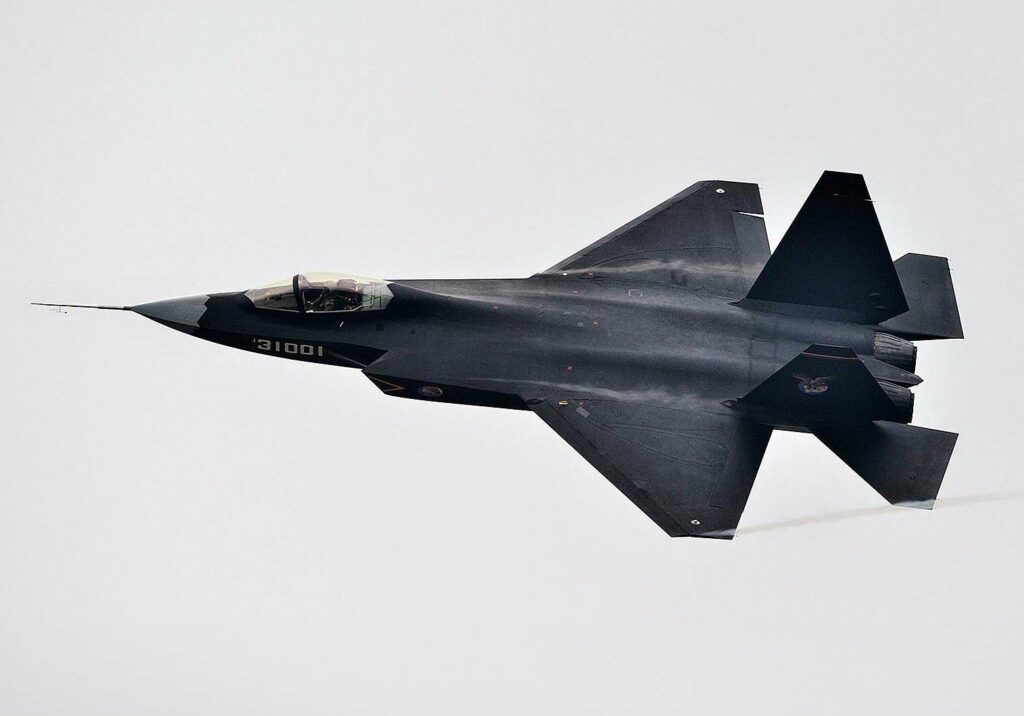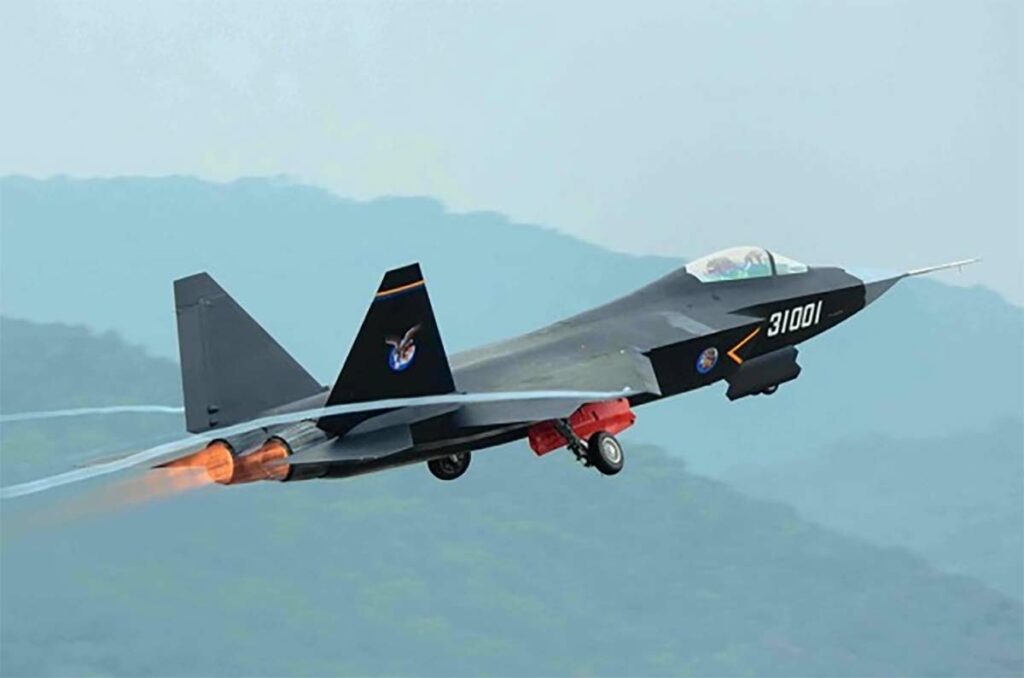The Shenyang J-31 Gyrfalcon is a twin-engine, fifth-generation stealth fighter developed by China’s AVIC, featuring advanced avionics and reduced radar cross-section.
The Shenyang J-31 Gyrfalcon, also known as the FC-31 or F-60, is a twin-engine, fifth-generation stealth fighter developed by Shenyang Aircraft Corporation under the Aviation Industry Corporation of China (AVIC). Designed for multirole capabilities, it features a diverterless supersonic inlet (DSI) design, low-aspect ratio trapezoidal wings with titanium spars, and twin vertical stabilizers. The aircraft measures 16.9 meters (55.4 feet) in length, 4.8 meters (15.7 feet) in height, and has a wingspan of 11.5 meters (37.7 feet). With an empty weight of approximately 17,000 kilograms (37,479 pounds) and a maximum takeoff weight of 25,000 kilograms (55,116 pounds), it is powered by two Klimov RD-93 turbofan engines, enabling speeds up to Mach 1.8 (approximately 2,200 km/h or 1,367 mph) and a maximum range of 4,000 kilometers (2,485 miles). The J-31 is equipped with advanced avionics, including multifunctional displays, helmet-mounted sights, and an electro-optical targeting system (EOTS), enhancing its operational effectiveness in various combat scenarios.
History of the Development of the Shenyang J-31 Gyrfalcon (FC-31 / F-60)
In the early 21st century, China’s rapid economic growth and increasing geopolitical influence underscored the need for a modern and capable air force. The success of the Chengdu J-20, China’s first fifth-generation stealth fighter, highlighted the nation’s advancements in aerospace technology. However, the J-20’s large size and specific design parameters left a niche for a more versatile, medium-sized stealth fighter that could fulfill both air superiority and ground attack roles.
Recognizing this opportunity, the Shenyang Aircraft Corporation (SAC), under AVIC, initiated the development of a new stealth fighter to complement the J-20. The project, internally designated as the F-60, was conceived as a private venture by SAC to attract both domestic and international customers. The aircraft was later designated as the FC-31 for export purposes and J-31 for domestic use.
The development program aimed to create a fifth-generation multirole fighter with advanced stealth capabilities, superior agility, and state-of-the-art avionics. The objective was to produce an aircraft that could compete with contemporary Western fighters, such as the American F-35 Lightning II, both in performance and marketability.
The J-31’s development was marked by several key milestones. In September 2011, a model labeled F-60 was showcased, indicating the project’s progression. By June 2012, images surfaced online depicting a heavily wrapped aircraft, believed to be the F-60 prototype, being transported on a highway. These images sparked widespread speculation and interest within the aviation community.
On October 31, 2012, the prototype, bearing the designation “31001,” undertook its maiden flight, signaling China’s commitment to advancing its stealth fighter capabilities. This event marked the country’s second fifth-generation stealth fighter development within a span of two years, following the J-20’s first flight in 2011.
The aircraft was publicly unveiled at the China International Aviation & Aerospace Exhibition in Zhuhai in November 2012, where a 1/4 scale model was displayed, highlighting its potential for export markets. In subsequent years, the J-31 underwent various refinements, including aerodynamic improvements and avionics upgrades, to enhance its performance and address initial design challenges.
Throughout its development, the J-31 has been referred to by various designations, including FC-31, F-60, and J-21. The moniker “Gyrfalcon” (鹘鹰) has also been associated with the aircraft, reflecting a tradition of naming Chinese military aircraft after birds of prey.
The J-31’s development reflects China’s strategic intent to modernize its military capabilities and establish a foothold in the international arms market. By offering a fifth-generation stealth fighter with multirole capabilities, China aims to cater to countries seeking advanced military aircraft but lacking access to Western platforms.

Design of the Shenyang J-31 Gyrfalcon (FC-31 / F-60)
The Shenyang J-31 Gyrfalcon’s design emphasizes stealth, agility, and multirole functionality. Its airframe incorporates features aimed at reducing radar cross-section (RCS) and enhancing aerodynamic performance.
The aircraft employs a diverterless supersonic inlet (DSI) design, featuring bumps and forward-swept inlet cowls, which contribute to its stealth characteristics by minimizing radar reflections. The chined fuselage design further aids in reducing RCS and improving aerodynamic efficiency.
The J-31 is equipped with low-aspect ratio trapezoidal wings, each with a 35° sweep and titanium spars, enhancing its aerodynamic performance. The twin vertical stabilizers and all-moving tailplanes contribute to improved maneuverability and control.
The aircraft’s internal weapons bays can each accommodate up to two missiles, allowing it to carry a variety of air-to-air and air-to-ground munitions while maintaining a low RCS. Additionally, the J-31 features three external hardpoints on each wing, enabling it to carry additional payloads when stealth is not a primary concern.
The cockpit is designed for a single pilot and is enclosed by a two-piece canopy, providing increased visibility. Advanced avionics include multifunctional displays, helmet-mounted sights, an electro-optical targeting system (EOTS), and advanced sensors and communication systems, enhancing situational awareness and combat effectiveness.
The J-31’s landing gear is of the tricycle type, with a double-wheel nose gear and ‘dogleg’ structured main gear, supporting carrier-based operations.
In summary, the Shenyang J-31 Gyrfalcon’s design integrates advanced stealth features, aerodynamic efficiency, and versatile weapon systems, positioning it as a formidable multirole fighter in modern aerial warfare.
Performance of the Shenyang J-31 Gyrfalcon (FC-31 / F-60)
The Shenyang J-31 Gyrfalcon is powered by two Klimov RD-93 afterburning turbofan engines, each generating an afterburning thrust of 84 kN (18,826 lbf). These engines enable the aircraft to reach speeds up to Mach 1.8, approximately 2,200 km/h (1,367 mph). The service ceiling is around 20,000 meters (65,617 feet), allowing operations at high altitudes.
The aircraft’s maximum takeoff weight is 25,000 kilograms (55,116 pounds), with an empty weight of approximately 17,000 kilograms (37,479 pounds). The J-31 has a combat radius of about 1,200 kilometers (746 miles) and a maximum range of over 2,000 kilometers (1,243 miles) when fitted with external fuel tanks.
In terms of agility, the J-31’s aerodynamic design, including its low-aspect ratio wings and advanced flight control systems, provides high maneuverability, essential for air superiority missions.
When compared to contemporaries like the American F-35 Lightning II, the J-31 offers competitive performance metrics. Both aircraft are designed as multirole stealth fighters with an emphasis on reduced radar cross-section and advanced avionics. However, the F-35 features a single-engine design, whereas the J-31 utilizes a twin-engine configuration, which may offer advantages in terms of thrust and redundancy.
The J-31’s payload capacity is substantial, with internal bays capable of carrying up to four missiles and external hardpoints allowing for additional ordnance or fuel tanks. This flexibility enables the aircraft to be configured for various mission profiles, from air-to-air combat to ground attack roles.
In summary, the Shenyang J-31 Gyrfalcon exhibits performance characteristics that align with modern fifth-generation fighter expectations, combining speed, agility, and payload versatility to fulfill a range of combat missions.
Variants of the Shenyang J-31 Gyrfalcon (FC-31 / F-60)
The Shenyang J-31 Gyrfalcon has undergone several iterations and developments, leading to distinct variants aimed at different operational requirements.
FC-31: The initial prototype, designated FC-31, was developed as a private venture by Shenyang Aircraft Corporation for potential export markets. This version featured the foundational design elements of the J-31, including its twin-engine configuration and stealth characteristics.
J-31B Gyrfalcon: Unveiled in July 2024, the J-31B represents an evolution of the original design. This variant is notably larger than the FC-31 and incorporates side weapon bays, each capable of carrying at least two missiles, in addition to a main weapon bay. These enhancements suggest a focus on increased payload capacity and versatility in armament configurations.
J-35: Developed for carrier-based operations, the J-35 variant includes modifications such as folding wings and catapult-launch bars to facilitate integration with aircraft carrier systems. This version is optimized for catapult-assisted takeoff, aligning with the capabilities of modern carriers like China’s Fujian.
J-35A: Introduced ahead of the 2024 China International Aviation & Aerospace Exhibition, the J-35A is a land-based variant of the J-35. While sharing core design elements with its carrier-based counterpart, the J-35A is tailored for operations from traditional airbases, potentially featuring adaptations suited to land-based missions.
These variants reflect the adaptability of the J-31 platform to meet diverse operational needs, from export-oriented models to specialized versions for naval and air force applications.

Military Use and Combat of the Shenyang J-31 Gyrfalcon (FC-31 / F-60)
As of February 2025, the Shenyang J-31 Gyrfalcon has not been deployed in active combat operations. The aircraft remains under development, with various iterations undergoing testing and evaluation for potential future deployment.
Armament:
The J-31 is designed to carry a diverse array of weaponry to fulfill its multirole capabilities. Its internal weapons bays can each house up to two missiles, allowing for a stealthy configuration by reducing radar cross-section. Additionally, the aircraft features three external hardpoints on each wing, enabling it to carry additional ordnance or fuel tanks when stealth is not a primary concern. This flexibility allows the J-31 to be equipped with various air-to-air missiles, such as the PL-9, PL-12, and PL-15, as well as air-to-ground munitions, including precision-guided bombs and anti-ship missiles.
Operational Status and Export Potential:
While the J-31 has not yet entered active service with the People’s Liberation Army Air Force (PLAAF) or the People’s Liberation Army Naval Air Force (PLANAF), there have been indications of interest from international customers. In January 2024, reports emerged that Pakistan had expressed intent to acquire the FC-31, the export variant of the J-31, to modernize its air force capabilities. This potential acquisition underscores the J-31’s appeal to countries seeking advanced fifth-generation fighter technology. citeturn0search3
Future Prospects:
The J-31’s development continues, with ongoing efforts to refine its design and enhance its performance. The aircraft’s adaptability for carrier-based operations, as evidenced by the J-35 variant, positions it as a potential asset for the PLANAF’s future carrier strike groups. As development progresses, the J-31 may become a key component of China’s advanced fighter fleet and a competitive option in the global defense market.
The Shenyang J-31 Gyrfalcon represents a significant advancement in China’s pursuit of fifth-generation fighter technology. Its design emphasizes stealth, agility, and multirole functionality, incorporating features such as diverterless supersonic inlets, internal weapons bays, and advanced avionics systems. The aircraft’s twin-engine configuration provides a balance of power and redundancy, contributing to its anticipated performance metrics, including speeds up to Mach 1.8 and a service ceiling of approximately 20,000 meters.
While still under development, the J-31’s potential for both land-based and carrier-based operations, as evidenced by its variants, positions it as a versatile platform capable of fulfilling various combat roles. Its prospective adoption by international partners, such as Pakistan, further underscores its appeal in the global defense market.
As the J-31 program progresses, continued focus on refining its systems, expanding its operational capabilities, and ensuring interoperability with existing military infrastructure will be crucial. The Gyrfalcon’s evolution reflects China’s commitment to advancing its aerospace industry and enhancing its strategic military assets.
Back to the Fighter Jet section.